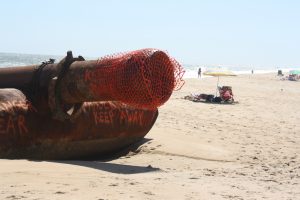
OCEAN CITY — The Army Corps of Engineers received an additional $56 million boost for dredging and other projects around the Baltimore District including a $11.1 million federal share for the next round of beach replenishment in Ocean City next fall.
The Ocean City beaches are routinely replenished every four years with periodic emergency projects as needed following storms and other natural events. Beach replenishment began in Ocean City in 1994 through a 50-year agreement with the town, Worcester County, and the state of Maryland partnering with the federal Army Corps of Engineers, which provided over 50% of the funding for the massive undertaking.
The Army Corps of Engineers (ACE) Baltimore District’s funding for fiscal year 2021 includes the federal share of beach replenishment in Ocean City. The resort’s beaches were last replenished in 2017 as part of the typical four-year cycle and are scheduled for a new phase this year. City Engineer Terry McGean said the plan is to begin beach replenishment next fall after the summer season.
The federal funding is coming through the corps’ 2021 Work Plan, which is congressionally-authorized funding specifically for ACE projects in the Baltimore District, which includes Ocean City. The $56 million in new funding supplements the roughly $78.5 million in funding outlined in the corps’ fiscal year 2021 administration budget for the district.
“These additional funds provide us the opportunity to keep navigation channels open safely and efficiently,” said ACE Baltimore District Commander Colonel John T. Litz. “This aids both national and local economies and helps restore critical Chesapeake Bay habitat for the more than 18 million people and 3,600 species of plants and animals that live within the bay’s watershed.”
The $11.1 million for Ocean City beach replenishment is an integral part of ensuring the continued long-term performance of the coastal storm risk management project. According to the ACE release, beach replenishment is estimated to have prevented over $927 million in damages since its completion in the 1990s.
The federal supplemental funding package announced this week also includes $4.4 million for the continued dredging of the Ocean City Inlet and the Assateague Island restoration project. A couple of times a year, the ACE sends the hopper dredge Currituck or its sister ship Murden to Ocean City to conduct maintenance dredging in and around the Inlet.
The Inlet and other channels in and around the commercial harbor naturally fill in and are in almost constant need of maintenance dredging, but the problem has become more acute in recent years to the point the Inlet is often impassable and unnavigable for larger vessels even on the highest of times. The $4.4 million in funding announced for the Assateague Bypass project will help supplement those efforts.
The Assateague bypass project removes material in and around the navigation channel with an emphasis on the ebb and flood shoals that traditionally trap sand moving southward toward Assateague. Dredged material is placed south of the inlet, just offshore of Assateague Island where it counteracts erosion.
The lion’s share of the $56 million-plus announced this week will go the maintenance and navigation dredging of the Baltimore Harbor and its channels to the tune of $22.8 million. In addition, the Maryland Port Administration will receive roughly $5 million of routine operation and maintenance activities, along with $515,000 for drift removal in the Baltimore harbor.

